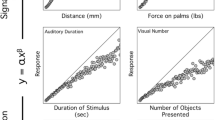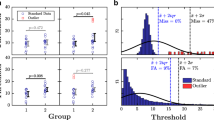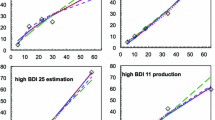Abstract
A general formulation of the power law is presented which has two special features: (1) negative exponents are admissible; and (2) the log law is a special limiting case. Estimation procedures, which provide joint estimates of the exponent and the absolute threshold, are derived for the direct ratio scaling methods. A solution is provided for theaveraging problem for ratio production and bisection scaling, two methods generating observations on the physical scale, and Monte Carlo methods are used to evaluate the resulting estimators.
Similar content being viewed by others
References
Churchman, C. W., Ackoff, R. L., and Arnoff, E. L.Introduction to operations research. New York: Wiley, 1961.
Ekman, G. Two generalized ratio scaling methods.J. Psychol., 1958,45, 287–295.
Fagot, R. F. A model for equisection scaling.Behavioral Science, 1961,6, 127–133.
Galanter, E. and Messick, S. The relation between category and magnitude scales of loudness.Psychol. Rev., 1961,68, 363–372.
Lewis, D.Quantitative methods in psychology. New York: McGraw-Hill, 1960.
Luce, R. D. On the possible psychophysical laws.Psychol. Rev., 1959,66, 81–95.
McGill, W. A. The slope of the loudness function: A puzzle. In H. Gulliksen and S. Messick (Eds.),Psychological scaling: theory and applications. New York: Wiley, 1960.
Stevens, S. S. On the averaging of data.Science, 1955,121, 113–116.
Stevens, S. S. On the psychophysical law.Psychol. Rev., 1957,64, 153–181.
Stevens, S. S. and Galanter, E. H. Ratio scales and category scales for a dozen perceptual continua.J. exp. Psychol., 1957,54, 377–411.
Stevens, S. S. Tactile vibration: Dynamics of sensory intensity.J. exp. Psychol., 1959,59, 210–218.
Torgerson, W. S.Theory and methods of scaling. New York: Wiley, 1958.
Tukey, J. W. On the comparative anatomy of transformations.Ann. math. Statist., 1957,28, 602–632.
Author information
Authors and Affiliations
Additional information
This research was supported by National Science Foundation grant G19210. Preparation of the manuscript was supported in part by a Public Health Service Fellowship (No. MSP-15800), from the National Institutes of Health, Public Health Service.
The author has benefited greatly from consultations with Ernest W. Adams who gave generously of his time and made valuable suggestions which have been incorporated into this work. Indebtedness is also acknowledged to Manard Stewart, especially for his collaboration in the evaluation of the estimation procedures reported in the last section; and to Raymond Hohle, who was helpful in the early stages of the research.
Rights and permissions
About this article
Cite this article
Fagot, R.F. On the psychophysical law and estimation procedures in psychophysical scaling. Psychometrika 28, 145–160 (1963). https://doi.org/10.1007/BF02289612
Received:
Revised:
Issue Date:
DOI: https://doi.org/10.1007/BF02289612




